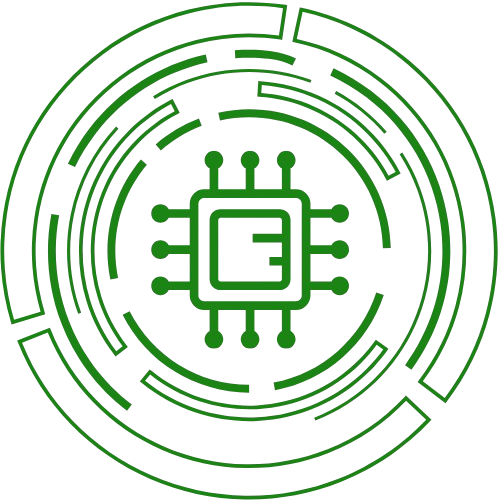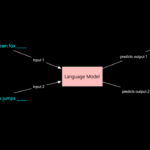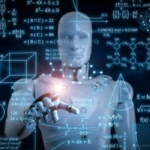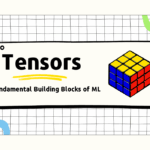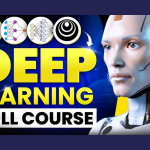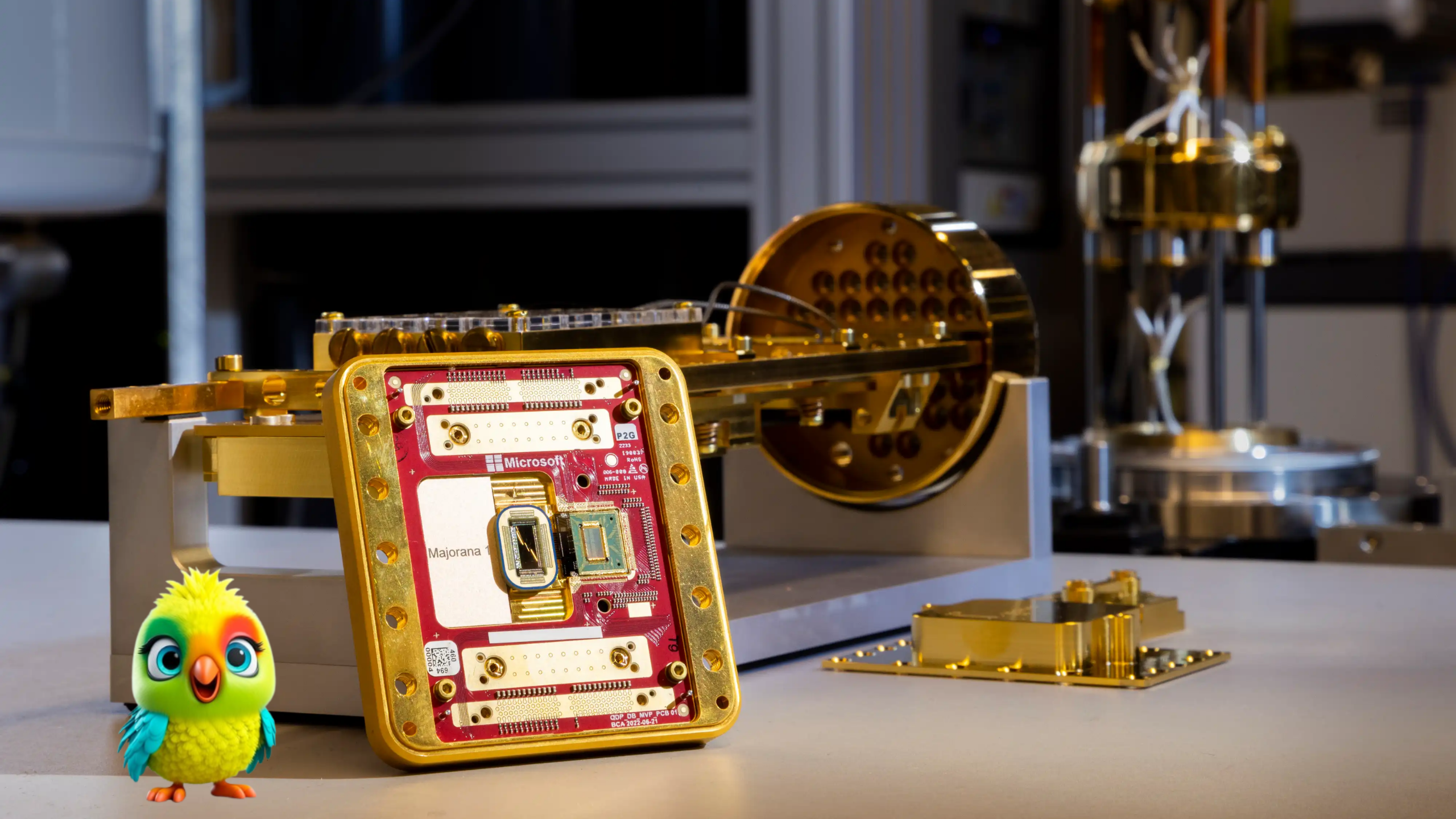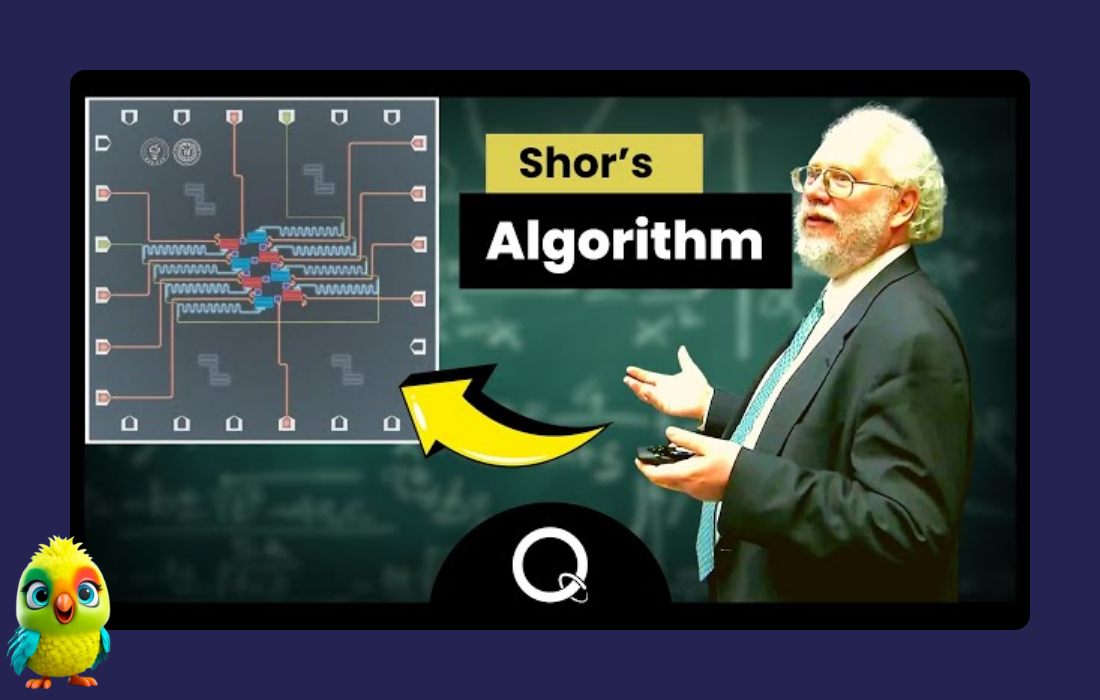Have you ever heard of a computer that can do things regular computers can’t? These special computers are called quantum computers. They are different from the computer you use at home or school because they use something called “qubits” instead of regular “bits”.
In this article, we’ll explore the fascinating world of quantum computers! We’ll break down how qubits work, dive into cool quantum tricks like superposition and entanglement, check out the pros and cons, meet the companies building these machines, and compare them to regular computers—all in simple, easy-to-understand terms.
Bits vs. Qubits
- A bit is like a light switch that can only be on or off, like a zero or a one. But a qubit can be both zero and one at the same time! This means quantum computers can do many things at once and work much faster than regular computers. It’s like having many helpers working on a task together instead of just one.
- Scientists first thought about quantum computers a long time ago, but it wasn’t until recently that they were able to build working models. Now, companies and researchers are working on making bigger and better quantum computers.
- Regular computers use bits, which are either ones or zeros, to process information. These bits are passed through logic gates, like AND, OR, NOT, and XOR, that manipulate the data and produce the desired output. These gates are made using transistors and are based on the properties of silicon semiconductors. While classical computers are efficient and fast, they struggle with problems that involve exponential complexity, such as factoring large numbers.
- On the other hand, quantum computers use a unit called a qubit to process information. A qubit is similar to a bit, but it has unique quantum properties such as superposition and entanglement. This means that a qubit can exist in both the one and zero states at the same time. This allows quantum computers to perform certain calculations much faster than classical computers.
- In a real quantum computer, qubits can be represented by various physical systems, such as electrons with spin, photons with polarization, trapped ions, and semiconducting circuits. With the ability to perform complex operations exponentially faster, quantum computers have the potential to revolutionize many industries and solve problems that were previously thought impossible.
Now let’s understand what exactly Quantum Superposition and Quantum Entanglement are!
Key Quantum Properties
1. Quantum Superposition
Qubits can do something really cool, they can be in two states at the same time! It’s like having two helpers working on a task instead of just one. It’s like a coin, a coin can be either heads or tails, but not both at the same time, but a qubit can be both zero and one at the same time. This means quantum computers can do many things at once and work much faster than regular computers. This special ability is called quantum superposition, and it’s what makes quantum computers so powerful!
Let’s dive a little deeper into Superposition
In the context of quantum computing, this means that a qubit can represent multiple values at the same time, rather than just a single value like a classical bit.
- A qubit can be described as a two-dimensional vector in a complex Hilbert space, with the two basis states being |0⟩ and |1⟩. A qubit can be in any state that is a linear combination of these two basis states, also known as a superposition state. This can be written as |ψ⟩ = α|0⟩ + β|1⟩, where α and β are complex numbers that represent the probability amplitudes of the qubit being in the |0⟩ and |1⟩ states, respectively. The probabilities of measuring the qubit in the |0⟩ and |1⟩ states are given by the squared moduli of the coefficients, |α|^2 and |β|^2, respectively.
- A qubit can exist in an infinite number of superpositions of the |0⟩ and |1⟩ states, each corresponding to a different probability distribution. This allows a qubit to perform multiple calculations simultaneously, greatly increasing its processing power. The ability of qubits to exist in multiple states at once enables the execution of quantum algorithms that can solve certain problems exponentially faster than classical algorithms. Eg: In regular computers, a group of 4 bits can represent 16 different values, but only one at a time. However, in a quantum computer, a group of 4 qubits can represent all 16 combinations simultaneously.
- A simple example of quantum superposition is Grover’s algorithm which is a quantum search algorithm that can search an unordered database with N entries in √N steps, whereas a classical algorithm would take N steps. Another example is Shor’s algorithm which is a quantum algorithm that can factorize a composite number in polynomial time, a problem that is considered to be hard for classical computers. This algorithm has important implications in the field of cryptography, as many encryption methods rely on the difficulty of factoring large numbers.
2. Quantum Entanglement
Let’s continue the same story from quantum superposition, the tiny helpers called qubits can be in two states at the same time? Well, sometimes those qubits can become special friends and work together even when they are far apart! This is called quantum entanglement. Imagine you have two toys, a car, and a boat. If you put the car toy in one room and the boat toy in another room, and you make them special friends so that if you change something about one toy, the other toy will change too. Even if you’re not looking at one toy, you’ll know what’s happening with the other toy just by looking at the other one. This is what quantum entanglement is, it’s like a secret connection between qubits. This is really important for quantum computers because it allows them to perform certain calculations much faster than regular computers and to communicate faster too. It’s a very special and powerful feature of quantum computers.
Let’s dive a little deeper into Entanglement
- In quantum mechanics where the properties of two or more quantum systems become correlated in such a way that the state of one system cannot be described independently of the others, even when the systems are separated by a large distance. In other words, the state of one system is dependent on the state of the other system, regardless of the distance between them.
- In the context of quantum computing, entanglement is used to perform certain calculations much faster than classical computers. In a quantum computer, qubits are used to represent the state of the system, and entanglement is used to correlate the state of multiple qubits, enabling them to perform multiple calculations simultaneously.
- An example of quantum entanglement is the Bell states, which are maximally entangled states of two qubits. The Bell states are a set of four quantum states that allow for fast and secure communication between two parties. These states are created by applying a specific operation called the Bell-state measurement, which allows for a fast and secure transfer of quantum information between two parties. Another example is Grover’s algorithm which utilizes the properties of entanglement to perform a search operation exponentially faster than any classical algorithm.
Advantages of Quantum Computers
- Speed: Quantum computers can perform certain calculations much faster than classical computers, making them well-suited for tasks that involve a large amount of data or complex mathematical calculations.
- Parallelism: Quantum computing allows for the parallel processing of information, which means that multiple computations can be performed simultaneously. This can significantly speed up certain tasks, such as searching large databases.
- Cryptography: Quantum computing has the potential to break many of the encryption methods currently used to secure data. However, it also has the potential to develop new and more secure encryption methods, which could be more resistant to attacks by hackers.
- Chemistry: Quantum computing can simulate the behavior of molecules at a level of detail that is not possible with classical computing. This could lead to new discoveries in drug design, materials science, and other areas.
Disadvantages of Quantum Computers
Quantum computers have the potential to revolutionize the field of computing, but they also come with a number of disadvantages. Some of the main challenges and limitations of quantum computing include:
- Noise and decoherence: One of the biggest challenges in building a quantum computer is the problem of noise and decoherence. Quantum systems are extremely sensitive to their environment, and any noise or disturbance can cause errors in the computation. This makes it difficult to maintain the delicate quantum state of the qubits and to perform accurate and reliable computations.
- Scalability: Another major challenge is scalability. Building a large-scale quantum computer with a large number of qubits is extremely difficult, as it requires the precise control of a large number of quantum systems. Currently, the number of qubits that can be controlled and manipulated in a laboratory setting is still quite small, which limits the potential of quantum computing.
- Error correction: Error correction is another major challenge in quantum computing. In classical computing, errors can be corrected using error-correcting codes, but in quantum computing, the errors are much more difficult to detect and correct, due to the nature of quantum systems.
- Lack of robust quantum algorithms: Even though some quantum algorithms have been developed, their number is still limited, and many problems that can be solved using classical computers have no known quantum algorithm.
- High cost: Building and maintaining a quantum computer is extremely expensive, due to the need for specialized equipment and highly trained personnel. The cost of building a large-scale quantum computer is also likely to be quite high, which could limit the availability of quantum computing to certain groups or organizations.
- Power consumption: Quantum computers are extremely power-hungry, due to the need to maintain the delicate quantum state of the qubits. This makes it difficult to scale up quantum computing to larger systems, as the power requirements become prohibitively high.
Quantum computers have the potential to revolutionize the field of computing, but they also come with a number of disadvantages. Some of the main challenges and limitations include noise and decoherence, scalability, error correction, lack of robust quantum algorithms, high cost, and power consumption.
Companies Building Quantum Computers
There are several multinational companies that have built and are currently working on building quantum computers. Some examples include:
- IBM: IBM has been working on quantum computing for several decades, and has built several generations of quantum computers. The company has made significant progress in the field, and its IBM Q quantum Experience platform allows anyone with an internet connection to access and runs experiments on its quantum computers. IBM’s most recent quantum computer, the IBM Q System One, is a 20-qubit machine that is designed for commercial use.
- Google: Google has been working on quantum computing for several years and has built several generations of quantum computers, including the 72-qubit Bristlecone quantum computer. The company claims that its quantum computer has reached “quantum supremacy,” meaning it can perform certain calculations faster than any classical computer.
- Alibaba: Alibaba has been investing heavily in quantum computing, and in 2017 it announced that it had built a quantum computer with 11 qubits. The company has also been developing its own quantum chips and is planning to release a cloud-based quantum computing service in the near future.
- Rigetti Computing: Rigetti Computing is a startup company that is building and developing superconducting qubits-based quantum computers. They offer a cloud-based quantum computing platform for researchers and developers to access their quantum computers.
- Intel: Intel has been developing its own quantum computing technology and has been building quantum processors and cryogenic control chips, which are used to control the quantum bits. In 2019, they announced the development of a 49-qubit quantum processor, one of the largest processors of its kind developed so far.
- D-Wave Systems: D-Wave Systems is a Canadian quantum computing company, founded in 1999, which is known for its development of the D-Wave One, the first commercially available quantum computer. D-Wave’s quantum computers are based on a technology called quantum annealing, which is a type of quantum optimization algorithm. They claim to have built the first commercially available quantum computer, but their system is not a fully general-purpose computer and it’s mainly used for optimization problems.
- Xanadu: Xanadu is a Canadian startup company that is building a new type of quantum computer based on a technology called photonic quantum computing. Photonic quantum computing is based on the manipulation of light particles (photons) to perform quantum computations. Xanadu’s approach is different from other companies that are building quantum computers, as it uses light instead of superconducting qubits. They are focusing on developing a general-purpose quantum computer that can run multiple algorithms.
Comparison: Classical vs. Quantum Computers
| Properties | Classical Computers | Quantum Computers |
|---|---|---|
| Basic Unit | Bits (0 or 1) | Qubits (0, 1 or both) |
| Superposition | Not possible | Qubits can exist in multiple superpositions |
| Entanglement | Not possible | Qubits can become entangled |
| Processing | Perform tasks one by one | Can perform multiple calculations simultaneously |
| Speed | Limited by Moore's Law and physical limitations | Faster and more efficient for certain problems |
| Algorithms | Classical algorithms | Quantum algorithms |
| Applications | Various industries and fields | Cryptography, optimization, chemistry, etc. |
Introduction to Complex Analysis
Complex analysis is one of the most beautiful and powerful branches of mathematics, with applications in physics, engineering, and many other fields. It deals with functions of complex numbers and explores their properties, differentiation, integration, and more.
What is a Complex Number?
A complex number is an extension of a real number and is written in the form:
\[ z = x + iy \]
where:
– \( x \) and \( y \) are real numbers,
– \( i \) is the imaginary unit, satisfying \( i^2 = -1 \).
The set of all complex numbers is denoted by \( \mathbb{C} \).
Functions of a Complex Variable
A complex function \( f \) takes a complex number \( z \) as input and outputs another complex number \( w \):
\[ w = f(z) \]
For example, \( f(z) = z^2 \) or \( f(z) = e^z \).
Key Concepts in Complex Analysis
1. Analytic (Holomorphic) Functions
A function \( f(z) \) is called analytic (or holomorphic) at a point if it is differentiable in a neighborhood of that point. Unlike real functions, complex differentiability imposes strong conditions—leading to the Cauchy-Riemann equations:
If \( f(z) = u(x,y) + iv(x,y) \), then:
\[ \frac{\partial u}{\partial x} = \frac{\partial v}{\partial y} \quad \text{and} \quad \frac{\partial u}{\partial y} = -\frac{\partial v}{\partial x} \]
2. Complex Integration: Cauchy’s Theorem
One of the most important results in complex analysis is Cauchy’s Theorem, which states that if \( f(z) \) is analytic inside and on a simple closed contour \( C \), then:
\[ \oint_C f(z) \, dz = 0 \]
This leads to Cauchy’s Integral Formula, which allows us to compute function values using integrals:
\[ f(a) = \frac{1}{2\pi i} \oint_C \frac{f(z)}{z – a} \, dz \]
3. Taylor and Laurent Series
– Taylor Series: If \( f(z) \) is analytic in a disk around \( a \), it can be expressed as:
\[ f(z) = \sum_{n=0}^{\infty} c_n (z – a)^n \]
– Laurent Series: For functions with singularities (poles), we use:
\[ f(z) = \sum_{n=-\infty}^{\infty} c_n (z – a)^n \]
4. Residue Theorem
The Residue Theorem is a powerful tool for evaluating complex integrals. If \( f(z) \) has isolated singularities inside a contour \( C \), then:
\[ \oint_C f(z) \, dz = 2\pi i \sum \text{Res}(f, a_k) \]
where \( \text{Res}(f, a_k) \) is the residue of \( f \) at \( a_k \).
Applications of Complex Analysis
– Physics: Used in quantum mechanics, fluid dynamics, and electromagnetism.
– Engineering: Signal processing, control theory, and electrical circuits.
– Number Theory: Analytic number theory (e.g., Riemann zeta function).
Conclusion
Complex analysis is a deep and elegant subject with far-reaching implications. Its theorems not only provide beautiful mathematical insights but also practical tools for solving real-world problems. Whether you’re studying pure mathematics or applied sciences, complex analysis is a fascinating field to explore!
Complex Analysis: Key Concepts with Examples and Derivations
In this blog, we will explore the fundamental concepts of complex analysis, including analytic functions, Cauchy-Riemann equations, complex integration, Taylor and Laurent series, and the Residue Theorem. We will derive key equations and work through examples for better understanding.
1. Analytic (Holomorphic) Functions & Cauchy-Riemann Equations
Definition
A function \( f(z) = u(x,y) + iv(x,y) \) is analytic at a point if it is differentiable in a neighborhood of that point.
Derivation of Cauchy-Riemann Equations
For \( f(z) \) to be differentiable, the limit:
\[
f'(z) = \lim_{\Delta z \to 0} \frac{f(z + \Delta z) – f(z)}{\Delta z}
\]
must exist and be the same regardless of how \( \Delta z \to 0 \).
Let \( \Delta z = \Delta x + i \Delta y \).
Approach 1: Along the real axis (\( \Delta y = 0 \))
\[
f'(z) = \frac{\partial f}{\partial x} = \frac{\partial u}{\partial x} + i \frac{\partial v}{\partial x}
\]
Approach 2: Along the imaginary axis (\( \Delta x = 0 \))
\[
f'(z) = \frac{\partial f}{\partial (iy)} = \frac{\partial u}{\partial y} \frac{1}{i} + \frac{\partial v}{\partial y} = -i \frac{\partial u}{\partial y} + \frac{\partial v}{\partial y}
\]
For the derivative to be consistent:
\[
\frac{\partial u}{\partial x} + i \frac{\partial v}{\partial x} = -i \frac{\partial u}{\partial y} + \frac{\partial v}{\partial y}
\]
Equating real and imaginary parts:
\[
\frac{\partial u}{\partial x} = \frac{\partial v}{\partial y} \quad \text{(1)}
\]
\[
\frac{\partial v}{\partial x} = -\frac{\partial u}{\partial y} \quad \text{(2)}
\]
These are the Cauchy-Riemann (C-R) Equations.
Example: Check if \( f(z) = z^2 \) is analytic
Let \( z = x + iy \), then:
\[
f(z) = (x + iy)^2 = x^2 – y^2 + i(2xy)
\]
Thus, \( u(x,y) = x^2 – y^2 \) and \( v(x,y) = 2xy \).
Now, check C-R equations:
1. \( \frac{\partial u}{\partial x} = 2x \) and \( \frac{\partial v}{\partial y} = 2x \) ✅
2. \( \frac{\partial v}{\partial x} = 2y \) and \( -\frac{\partial u}{\partial y} = 2y \) ✅
Since the C-R equations hold, \( f(z) = z^2 \) is analytic everywhere (entire).
2. Complex Integration & Cauchy’s Theorem
Cauchy’s Theorem
If \( f(z) \) is analytic inside and on a simple closed contour \( C \), then:
\[
\oint_C f(z) \, dz = 0
\]
Derivation (Sketch)
Using Green’s Theorem:
\[
\oint_C (u \, dx – v \, dy) + i \oint_C (v \, dx + u \, dy) = 0
\]
Applying C-R equations (\( \frac{\partial u}{\partial x} = \frac{\partial v}{\partial y} \), \( \frac{\partial v}{\partial x} = -\frac{\partial u}{\partial y} \)) makes both integrals vanish.
Example: Integrate \( f(z) = z^2 \) over a unit circle
Parametrize \( C \) as \( z = e^{i\theta} \), \( dz = ie^{i\theta} d\theta \):
\[
\oint_{|z|=1} z^2 \, dz = \int_0^{2\pi} e^{2i\theta} \cdot ie^{i\theta} \, d\theta = i \int_0^{2\pi} e^{3i\theta} \, d\theta = 0
\]
Since \( e^{3i\theta} \) integrates to zero over \( 2\pi \), the result matches Cauchy’s Theorem.
3. Cauchy’s Integral Formula
Statement
If \( f(z) \) is analytic inside and on \( C \), then for any \( a \) inside \( C \):
\[
f(a) = \frac{1}{2\pi i} \oint_C \frac{f(z)}{z – a} \, dz
\]
Derivation
Consider a small circle \( C_\epsilon \) around \( a \). By Cauchy’s Theorem:
\[
\oint_C \frac{f(z)}{z – a} \, dz = \oint_{C_\epsilon} \frac{f(z)}{z – a} \, dz
\]
Since \( f(z) \approx f(a) \) near \( a \), we get:
\[
f(a) \oint_{C_\epsilon} \frac{1}{z – a} \, dz = f(a) \cdot 2\pi i
\]
Example: Compute \( \oint_{|z|=2} \frac{e^z}{z – 1} \, dz \)
Here, \( f(z) = e^z \) is analytic, and \( a = 1 \) is inside \( |z| = 2 \).
By Cauchy’s Integral Formula:
\[
\oint_{|z|=2} \frac{e^z}{z – 1} \, dz = 2\pi i \cdot f(1) = 2\pi i \cdot e
\]
4. Taylor & Laurent Series
Taylor Series (for Analytic Functions)
If \( f(z) \) is analytic in a disk \( |z – a| < R \), then:
\[
f(z) = \sum_{n=0}^\infty \frac{f^{(n)}(a)}{n!} (z – a)^n
\]
Example: Expand \( e^z \) around \( z = 0 \)
Since \( e^z \) is entire:
\[
e^z = \sum_{n=0}^\infty \frac{z^n}{n!} = 1 + z + \frac{z^2}{2!} + \frac{z^3}{3!} + \cdots
\]
Laurent Series (for Functions with Singularities)
If \( f(z) \) has a singularity at \( a \), it can be written as:
\[
f(z) = \sum_{n=-\infty}^\infty c_n (z – a)^n
\]
where:
\[
c_n = \frac{1}{2\pi i} \oint_C \frac{f(z)}{(z – a)^{n+1}} \, dz
\]
Example: Find the Laurent series of \( f(z) = \frac{1}{z(z-1)} \) around \( z=0 \)
Using partial fractions:
\[
f(z) = \frac{1}{z-1} – \frac{1}{z} = -\sum_{n=0}^\infty z^n – \frac{1}{z} \quad \text{(for \( 0 < |z| < 1 \))}
\]
5. Residue Theorem
Statement
If \( f(z) \) has isolated singularities inside \( C \), then:
\[
\oint_C f(z) \, dz = 2\pi i \sum \text{Res}(f, a_k)
\]
Example: Compute \( \oint_{|z|=2} \frac{1}{z^2 – 1} \, dz \)
Poles at \( z = 1 \) and \( z = -1 \).
Compute residues:
\[
\text{Res}(f, 1) = \lim_{z \to 1} (z-1) \frac{1}{(z-1)(z+1)} = \frac{1}{2}
\]
\[
\text{Res}(f, -1) = \lim_{z \to -1} (z+1) \frac{1}{(z-1)(z+1)} = -\frac{1}{2}
\]
Thus:
\[
\oint_{|z|=2} \frac{1}{z^2 – 1} \, dz = 2\pi i \left( \frac{1}{2} – \frac{1}{2} \right) = 0
\]
Conclusion
Complex analysis provides powerful tools for solving integrals, expanding functions, and understanding singularities. By mastering Cauchy-Riemann equations, integration techniques, series expansions, and residues, we unlock deep mathematical insights with wide applications in physics and engineering.
Arithmetic Operations in Complex Analysis
Complex numbers extend real numbers by introducing the imaginary unit \( i \), where \( i^2 = -1 \). In complex analysis, we perform arithmetic operations (addition, subtraction, multiplication, division, and exponentiation) on complex numbers. Below, we derive and illustrate each operation with examples.
1. Addition of Complex Numbers
Given two complex numbers:
\[
z_1 = x_1 + iy_1, \quad z_2 = x_2 + iy_2
\]
Addition is performed component-wise:
\[
z_1 + z_2 = (x_1 + x_2) + i(y_1 + y_2)
\]
Example
Let \( z_1 = 3 + 4i \) and \( z_2 = 1 – 2i \). Then:
\[
z_1 + z_2 = (3 + 1) + i(4 – 2) = 4 + 2i
\]
2. Subtraction of Complex Numbers
Subtraction is also component-wise:
\[
z_1 – z_2 = (x_1 – x_2) + i(y_1 – y_2)
\]
Example
For \( z_1 = 5 + 3i \) and \( z_2 = 2 – i \):
\[
z_1 – z_2 = (5 – 2) + i(3 – (-1)) = 3 + 4i
\]
3. Multiplication of Complex Numbers
Multiplication follows the distributive property and uses \( i^2 = -1 \):
\[
z_1 \cdot z_2 = (x_1 + iy_1)(x_2 + iy_2) = (x_1x_2 – y_1y_2) + i(x_1y_2 + y_1x_2)
\]
Example
Let \( z_1 = 1 + 2i \) and \( z_2 = 3 – i \). Then:
\[
z_1 \cdot z_2 = (1)(3) + (1)(-i) + (2i)(3) + (2i)(-i) = 3 – i + 6i – 2i^2
\]
\[
= 3 + 5i – 2(-1) = 3 + 5i + 2 = 5 + 5i
\]
4. Division of Complex Numbers
To divide \( \frac{z_1}{z_2} \), we multiply numerator and denominator by the complex conjugate of \( z_2 \):
\[
\frac{z_1}{z_2} = \frac{x_1 + iy_1}{x_2 + iy_2} \cdot \frac{x_2 – iy_2}{x_2 – iy_2} = \frac{(x_1x_2 + y_1y_2) + i(y_1x_2 – x_1y_2)}{x_2^2 + y_2^2}
\]
Example
Let \( z_1 = 4 + 3i \) and \( z_2 = 1 – 2i \). Then:
\[
\frac{z_1}{z_2} = \frac{4 + 3i}{1 – 2i} \cdot \frac{1 + 2i}{1 + 2i} = \frac{(4)(1) + (3)(2) + i(3 \cdot 1 – 4 \cdot 2)}{1^2 + (-2)^2}
\]
\[
= \frac{4 + 6 + i(3 – 8)}{1 + 4} = \frac{10 – 5i}{5} = 2 – i
\]
5. Exponentiation of Complex Numbers
(a) Integer Powers
Using De Moivre’s Theorem for \( z = re^{i\theta} \):
\[
z^n = r^n e^{in\theta} = r^n (\cos n\theta + i \sin n\theta)
\]
Example
Compute \( (1 + i)^4 \):
1. Convert to polar form: \( 1 + i = \sqrt{2} e^{i\pi/4} \).
2. Apply De Moivre’s Theorem:
\[
(1 + i)^4 = (\sqrt{2})^4 e^{i \cdot 4 \cdot \pi/4} = 4 e^{i\pi} = 4(-1 + 0i) = -4
\]
(b) Complex Exponentials (Euler’s Formula)
\[
e^{z} = e^{x + iy} = e^x (\cos y + i \sin y)
\]
Example
Compute \( e^{1 + i\pi} \):
\[
e^{1 + i\pi} = e^1 (\cos \pi + i \sin \pi) = e(-1 + 0i) = -e
\]
6. Complex Conjugation
The complex conjugate of \( z = x + iy \) is:
\[
\overline{z} = x – iy
\]
Properties
– \( z + \overline{z} = 2 \text{Re}(z) \)
– \( z – \overline{z} = 2i \text{Im}(z) \)
– \( z \cdot \overline{z} = |z|^2 = x^2 + y^2 \)
Example
For \( z = 3 + 4i \):
\[
\overline{z} = 3 – 4i
\]
\[
z \cdot \overline{z} = (3 + 4i)(3 – 4i) = 9 + 16 = 25 = |z|^2
\]
Summary of Complex Arithmetic
| Operation | Formula | Example |
|---|---|---|
| Addition | (x₁ + i·y₁) + (x₂ + i·y₂) = (x₁ + x₂) + i·(y₁ + y₂) | (3 + 4i) + (1 − 2i) = 4 + 2i |
| Subtraction | (x₁ + i·y₁) − (x₂ + i·y₂) = (x₁ − x₂) + i·(y₁ − y₂) | (5 + 3i) − (2 − i) = 3 + 4i |
| Multiplication | (x₁x₂ − y₁y₂) + i·(x₁y₂ + y₁x₂) | (1 + 2i)(3 − i) = 5 + 5i |
| Division | [(x₁x₂ + y₁y₂) + i·(y₁x₂ − x₁y₂)] / (x₂² + y₂²) | (4 + 3i) / (1 − 2i) = 2 − i |
| Exponentiation | zⁿ = rⁿ(cos(nθ) + i·sin(nθ)) | (1 + i)⁴ = −4 |
| Conjugation | conj(z) = x − i·y | conj(3 + 4i) = 3 − 4i |
Conclusion
Complex arithmetic extends real-number operations while introducing new properties (e.g., conjugation, polar form). These operations are foundational in complex analysis, signal processing, quantum mechanics, and electrical engineering.
Complex Numbers on a Plane, Cylindrical & Spherical Coordinates, Euler’s Formula, and Hyperbolic Functions
1. Complex Numbers on the Plane
A complex number \( z \) is represented as:
\[
z = x + iy
\]
where:
– \( x = \text{Re}(z) \) (real part),
– \( y = \text{Im}(z) \) (imaginary part),
– \( i = \sqrt{-1} \).
Geometric Representation (Argand Plane)
– The complex plane (Argand plane) plots:
– Real axis (x-axis): Re(z)
– Imaginary axis (y-axis): Im(z)
– A complex number \( z = x + iy \) corresponds to a point \( (x, y) \).
Polar Form of Complex Numbers
A complex number can also be written in polar form:
\[
z = r (\cos \theta + i \sin \theta)
\]
where:
– \( r = |z| = \sqrt{x^2 + y^2} \) (magnitude),
– \( \theta = \arg(z) = \tan^{-1}(y/x) \) (argument).
Example
For \( z = 1 + i \):
– \( r = \sqrt{1^2 + 1^2} = \sqrt{2} \)
– \( \theta = \tan^{-1}(1/1) = \frac{\pi}{4} \)
– Polar form: \( z = \sqrt{2} \left( \cos \frac{\pi}{4} + i \sin \frac{\pi}{4} \right) \)
2. Cylindrical and Spherical Coordinates for Complex Numbers
(a) Cylindrical Coordinates (for \( \mathbb{C} \))
– Equivalent to polar coordinates:
\[
z = r e^{i\theta}
\]
where:
– \( r = \text{magnitude} \),
– \( \theta = \text{angle (azimuthal)} \).
(b) Spherical Coordinates (for \( \mathbb{C}^2 \))
– Used in higher dimensions (e.g., quaternions).
– For a 3D extension (not standard for \( \mathbb{C} \)):
\[
(r, \theta, \phi)
\]
where:
– \( r = \text{magnitude} \),
– \( \theta = \text{polar angle} \),
– \( \phi = \text{azimuthal angle} \).
3. Deriving Euler’s Formula
Euler’s formula connects complex exponentials and trigonometry:
\[
e^{i\theta} = \cos \theta + i \sin \theta
\]
Proof (Using Taylor Series)
1. Exponential function expansion:
\[
e^{x} = 1 + x + \frac{x^2}{2!} + \frac{x^3}{3!} + \cdots
\]
2. Let \( x = i\theta \):
\[
e^{i\theta} = 1 + i\theta + \frac{(i\theta)^2}{2!} + \frac{(i\theta)^3}{3!} + \cdots
\]
3. Simplify using \( i^2 = -1 \):
\[
e^{i\theta} = \left(1 – \frac{\theta^2}{2!} + \frac{\theta^4}{4!} – \cdots \right) + i\left(\theta – \frac{\theta^3}{3!} + \cdots \right)
\]
4. Recognize Taylor series for \( \cos \theta \) and \( \sin \theta \):
\[
e^{i\theta} = \cos \theta + i \sin \theta
\]
Corollary: Euler’s Identity
When \( \theta = \pi \):
\[
e^{i\pi} + 1 = 0
\]
4. Expressing Complex Numbers in Euler Form
A complex number \( z = x + iy \) can be written as:
\[
z = r e^{i\theta}
\]
where:
– \( r = \sqrt{x^2 + y^2} \),
– \( \theta = \tan^{-1}(y/x) \).
Example
Convert \( z = 1 + i \) to Euler form:
– \( r = \sqrt{1^2 + 1^2} = \sqrt{2} \),
– \( \theta = \frac{\pi}{4} \),
– Thus, \( z = \sqrt{2} e^{i\pi/4} \).
5. Deriving Hyperbolic Functions (sinh, cosh, tanh)
Hyperbolic functions are analogs of trigonometric functions but for hyperbolas.
Let me expand on Euler’s formula and its implications more deeply, connecting several fundamental concepts in complex analysis.
1. Euler’s Formula Foundations
The seminal identity:
\[ e^{ix} = \cos x + i\sin x \]
emerges from Taylor series expansions:
– Exponential: \( e^{z} = \sum_{n=0}^\infty \frac{z^n}{n!} \)
– Cosine: \( \cos x = \sum_{n=0}^\infty \frac{(-1)^n x^{2n}}{(2n)!} \)
– Sine: \( \sin x = \sum_{n=0}^\infty \frac{(-1)^n x^{2n+1}}{(2n+1)!} \)
When \( z = ix \), the exponential series splits into real (cosine) and imaginary (sine) components.
2. Geometric Interpretation
Euler’s formula establishes a profound connection between:
– Exponential functions (growth/decay)
– Trigonometry (circular motion)
– Complex numbers (2D plane)
This maps complex numbers to the unit circle where:
– The magnitude \( |e^{ix}| = \sqrt{\cos^2x + \sin^2x} = 1 \)
– The angle \( x \) represents rotation in radians
3. Deriving Hyperbolic Functions
The same methodology yields definitions for hyperbolic functions:
From Euler’s Formulas:
\[ \cos x = \frac{e^{ix} + e^{-ix}}{2} \]
\[ \sin x = \frac{e^{ix} – e^{-ix}}{2i} \]
Hyperbolic Analogues (remove \( i \)):
\[ \cosh x = \frac{e^{x} + e^{-x}}{2} \]
\[ \sinh x = \frac{e^{x} – e^{-x}}{2} \]
Key observation:
Hyperbolic functions are essentially trigonometric functions rotated by \( \pi/2 \) in the complex plane (\( x \rightarrow ix \)).
4. Complex Trigonometric Identities
For any complex number \( z \in \mathbb{C} \):
\[ \sin z = \frac{e^{iz} – e^{-iz}}{2i} \]
\[ \cos z = \frac{e^{iz} + e^{-iz}}{2} \]
Example Calculation:
Compute \( \sin(i) \):
\[
\sin(i) = \frac{e^{i(i)} – e^{-i(i)}}{2i} = \frac{e^{-1} – e^{1}}{2i} = i\left(\frac{e^1 – e^{-1}}{2}\right) = i\sinh(1)
\]
5. Applications in Advanced Mathematics
A. Fourier Transforms
Euler’s formula underpins Fourier analysis:
\[ f(x) = \sum_{k=-\infty}^\infty c_k e^{ikx} \]
where complex exponentials decompose signals into frequencies.
B. Differential Equations
Solutions to:
\[ \frac{d^2y}{dx^2} + k^2y = 0 \]
are expressed compactly as \( y = Ae^{ikx} + Be^{-ikx} \).
C. Quantum Mechanics
The Schrödinger equation:
\[ i\hbar\frac{\partial \psi}{\partial t} = \hat{H}\psi \]
relies on complex exponentials for wavefunctions \( \psi \).
6. Visualization Table
| Representation | Formula | Relationship / Interpretation |
|---|---|---|
| Exponential Form | $e^{ix}$ | Fundamental complex exponential expression |
| Trigonometric Form | $\cos x + i \sin x$ | Derived from Euler’s formula using polar coordinates |
| Matrix Form | $\begin{bmatrix} \cos x & -\sin x \\ \sin x & \cos x \end{bmatrix}$ | Acts as a 2D rotation matrix |
| Hyperbolic Form | $\cosh(ix) = \cos x$ | Links complex and hyperbolic functions via $i$ |
7. Physical Interpretation
– Electrical Engineering: AC circuits use \( e^{i\omega t} \) to represent oscillating voltages.
– Control Theory: Laplace transforms employ \( s = \sigma + i\omega \) for system stability analysis.
– Relativity: Rapidities in special relativity involve hyperbolic functions.
8. Extensions
For any angle \( \theta \) and complex \( z \):
\[ e^z = e^{x+iy} = e^x(\cos y + i\sin y) \]
generalizing to entire complex plane.
This unified framework demonstrates how Euler’s formula serves as a Rosetta Stone, translating between exponential, trigonometric, and hyperbolic languages in mathematics.
Definitions
1. Hyperbolic Sine (sinh):
\[
\sinh x = \frac{e^x – e^{-x}}{2}
\]
2. Hyperbolic Cosine (cosh):
\[
\cosh x = \frac{e^x + e^{-x}}{2}
\]
3. Hyperbolic Tangent (tanh):
\[
\tanh x = \frac{\sinh x}{\cosh x} = \frac{e^x – e^{-x}}{e^x + e^{-x}}
\]
Relation to Trigonometry via Complex Numbers
Using Euler’s formula:
\[
\sin(x) = \frac{e^{ix} – e^{-ix}}{2i}, \quad \cos(x) = \frac{e^{ix} + e^{-ix}}{2}
\]
Thus:
\[
\sinh(ix) = i \sin(x), \quad \cosh(ix) = \cos(x)
\]
6. Introduction to Trigonometry in Complex Analysis
Key Trigonometric Functions
1. Sine and Cosine:
\[
\sin z = \frac{e^{iz} – e^{-iz}}{2i}, \quad \cos z = \frac{e^{iz} + e^{-iz}}{2}
\]
2. Tangent:
\[
\tan z = \frac{\sin z}{\cos z}
\]
Example
Compute \( \sin(i) \):
\[
\sin(i) = \frac{e^{i \cdot i} – e^{-i \cdot i}}{2i} = \frac{e^{-1} – e^{1}}{2i} = i \cdot \frac{e – e^{-1}}{2} = i \sinh(1)
\]
Conclusion
– Complex numbers can be represented geometrically in polar, cylindrical, and spherical coordinates.
– Euler’s formula connects exponential and trigonometric functions.
– Hyperbolic functions extend trigonometric functions to hyperbolas and appear in complex analysis.
– Trigonometric functions generalize to complex arguments via exponentials.
The Deep Connection Between Matrices and Quantum Mechanics: Unitary Transformations, Eigenvalues, and Beyond
Introduction
Matrices are fundamental to quantum mechanics, serving as the mathematical backbone for transformations, state representations, and observable measurements. In this blog, we’ll explore:
1. Matrix transformations in quantum mechanics (Unitary & Hermitian matrices)
2. Eigenvalues and eigenvectors (How they define quantum states)
3. Solving polynomial equations (Quadratic, cubic, and depressed cubic equations via matrix methods)
4. Applications in quantum computing (Qubit operations, quantum gates)
1. Matrices in Quantum Mechanics
Unitary Matrices (Quantum Evolution)
A matrix U is unitary if:
\[
U^\dagger U = U U^\dagger = I
\]
where \( U^\dagger \) is the conjugate transpose.
Why are they important?
– They preserve the norm (length) of quantum state vectors.
– They describe reversible quantum operations (e.g., quantum gates in quantum computing).
Example: Pauli-X Gate (Quantum NOT Gate)
\[
X = \begin{pmatrix} 0 & 1 \\ 1 & 0 \end{pmatrix}
\]
– Unitary check: \( X^\dagger X = I \).
Hermitian Matrices (Quantum Observables)
A matrix H is Hermitian if:
\[
H^\dagger = H
\]
Key properties:
– Real eigenvalues (corresponding to measurable quantities in quantum mechanics).
– Orthogonal eigenvectors (basis for quantum states).
Example: Pauli-Z Gate (Quantum Phase Flip)
\[
Z = \begin{pmatrix} 1 & 0 \\ 0 & -1 \end{pmatrix}
\]
– Hermitian check: \( Z^\dagger = Z \).
2. Eigenvalues & Eigenvectors in Quantum Mechanics
What Are They?
For a matrix A, an eigenvector \( \mathbf{v} \) and eigenvalue \( \lambda \) satisfy:
\[
A \mathbf{v} = \lambda \mathbf{v}
\]
Quantum Interpretation:
– Eigenvalues → Possible measurement outcomes (e.g., energy levels).
– Eigenvectors → Quantum states corresponding to those outcomes.
How to Find Them
1. Solve the characteristic equation:
\[
\det(A – \lambda I) = 0
\]
2. For each eigenvalue, find the eigenvector:
\[
(A – \lambda I) \mathbf{v} = 0
\]
Example: Eigenvalues of Pauli-Y Matrix
\[
Y = \begin{pmatrix} 0 & -i \\ i & 0 \end{pmatrix}
\]
– Characteristic equation: \( \lambda^2 – 1 = 0 \) → \( \lambda = \pm 1 \).
– Eigenvectors: \( \begin{pmatrix} 1 \\ i \end{pmatrix} \) (for \( \lambda = 1 \)) and \( \begin{pmatrix} 1 \\ -i \end{pmatrix} \) (for \( \lambda = -1 \)).
3. Solving Polynomial Equations Using Matrices
Quadratic Equations
Given \( x^2 + bx + c = 0 \), we can represent it as a companion matrix:
\[
C = \begin{pmatrix} 0 & -c \\ 1 & -b \end{pmatrix}
\]
– Eigenvalues of C = roots of the quadratic equation.
Cubic Equations
For \( x^3 + ax^2 + bx + c = 0 \), the companion matrix is:
\[
C = \begin{pmatrix} 0 & 0 & -c \\ 1 & 0 & -b \\ 0 & 1 & -a \end{pmatrix}
\]
– Eigenvalues of C = roots of the cubic equation.
Depressed Cubic Equation (No Quadratic Term)
Given \( x^3 + px + q = 0 \), the companion matrix simplifies to:
\[
C = \begin{pmatrix} 0 & 0 & -q \\ 1 & 0 & -p \\ 0 & 1 & 0 \end{pmatrix}
\]
– Eigenvalues still give the roots.
Example: Solving \( x^3 – 6x^2 + 11x – 6 = 0 \)
– Companion matrix:
\[
C = \begin{pmatrix} 0 & 0 & 6 \\ 1 & 0 & -11 \\ 0 & 1 & 6 \end{pmatrix}
\]
– Eigenvalues: \( \lambda = 1, 2, 3 \) → roots of the equation.
4. Applications in Quantum Computing
Quantum Gates as Unitary Matrices
– Hadamard Gate (Superposition):
\[
H = \frac{1}{\sqrt{2}} \begin{pmatrix} 1 & 1 \\ 1 & -1 \end{pmatrix}
\]
– CNOT Gate (Entanglement):
\[
CNOT = \begin{pmatrix} 1 & 0 & 0 & 0 \\ 0 & 1 & 0 & 0 \\ 0 & 0 & 0 & 1 \\ 0 & 0 & 1 & 0 \end{pmatrix}
\]
Quantum State Evolution
A quantum state \( |\psi\rangle \) evolves under a unitary matrix \( U \):
\[
|\psi’\rangle = U |\psi\rangle
\]
– Example: Applying the Hadamard gate to \( |0\rangle \):
\[
H|0\rangle = \frac{|0\rangle + |1\rangle}{\sqrt{2}}
\]
Conclusion
Matrices are the language of quantum mechanics:
– Unitary matrices → Quantum operations (reversible).
– Hermitian matrices → Observable quantities (energy, spin).
– Eigenvalues & eigenvectors → Measurement outcomes and states.
– Polynomial roots → Found via matrix eigenvalues.
Understanding these concepts is crucial for **quantum computing, quantum algorithms, and quantum simulations**.
Further Reading
– Nielsen & Chuang, Quantum Computation and Quantum Information.
– Gilbert Strang, Linear Algebra and Its Applications.
– Quantum computing frameworks: Qiskit (IBM), Cirq (Google).
A Deep Dive into Qubits, Superposition, and Quantum Gates: How Qubits Transform Under Operations
Introduction: The Quantum Bit (Qubit)
In classical computing, a bit is a binary unit that exists in one of two definite states: 0 or 1. Quantum computing, however, introduces the qubit—a quantum-mechanical system that can exist in a superposition of states, enabling exponentially more powerful computations.
Mathematical Representation of a Qubit
A qubit is represented as a unit vector in a two-dimensional complex Hilbert space. Its general state is:
\[
|\psi\rangle = \alpha |0\rangle + \beta |1\rangle
\]
where:
– \( \alpha \) and \( \beta \) are complex probability amplitudes,
– \( |0\rangle \) and \( |1\rangle \) are the computational basis states,
– The normalization condition \( |\alpha|^2 + |\beta|^2 = 1 \) ensures the total probability is 1.
Basis States in Vector Form:
\[
|0\rangle = \begin{pmatrix} 1 \\ 0 \end{pmatrix}, \quad |1\rangle = \begin{pmatrix} 0 \\ 1 \end{pmatrix}
\]
1. Superposition: The Quantum Advantage
Unlike classical bits, qubits can be in a linear combination of \( |0\rangle \) and \( |1\rangle \). This allows quantum computers to process multiple states simultaneously.
Example: Creating a Superposition with the Hadamard Gate
The Hadamard gate (H) transforms a basis state into an equal superposition:
\[
H = \frac{1}{\sqrt{2}} \begin{pmatrix} 1 & 1 \\ 1 & -1 \end{pmatrix}
\]
Action on \( |0\rangle \):
\[
H|0\rangle = \frac{1}{\sqrt{2}} \begin{pmatrix} 1 & 1 \\ 1 & -1 \end{pmatrix} \begin{pmatrix} 1 \\ 0 \end{pmatrix} = \frac{1}{\sqrt{2}} \begin{pmatrix} 1 \\ 1 \end{pmatrix} = \frac{|0\rangle + |1\rangle}{\sqrt{2}}
\]
– Interpretation: The qubit is now in a state where it has a 50
Action on \( |1\rangle \):
\[
H|1\rangle = \frac{1}{\sqrt{2}} \begin{pmatrix} 1 & 1 \\ 1 & -1 \end{pmatrix} \begin{pmatrix} 0 \\ 1 \end{pmatrix} = \frac{1}{\sqrt{2}} \begin{pmatrix} 1 \\ -1 \end{pmatrix} = \frac{|0\rangle – |1\rangle}{\sqrt{2}}
\]
– Interpretation: The qubit is in a superposition with a negative phase on \( |1\rangle \), which is crucial for quantum interference.
2. Single-Qubit Quantum Gates
(A) Pauli-X Gate (Quantum NOT Gate)
The Pauli-X gate flips the state of a qubit, analogous to a classical NOT gate:
\[
X = \begin{pmatrix} 0 & 1 \\ 1 & 0 \end{pmatrix}
\]
Action on \( |0\rangle \):
\[
X|0\rangle = \begin{pmatrix} 0 & 1 \\ 1 & 0 \end{pmatrix} \begin{pmatrix} 1 \\ 0 \end{pmatrix} = \begin{pmatrix} 0 \\ 1 \end{pmatrix} = |1\rangle
\]
Action on \( |1\rangle \):
\[
X|1\rangle = \begin{pmatrix} 0 & 1 \\ 1 & 0 \end{pmatrix} \begin{pmatrix} 0 \\ 1 \end{pmatrix} = \begin{pmatrix} 1 \\ 0 \end{pmatrix} = |0\rangle
\]
(B) Pauli-Z Gate (Phase Flip Gate)
The Pauli-Z gate introduces a phase shift of \( \pi \) (180°) to the \( |1\rangle \) state:
\[
Z = \begin{pmatrix} 1 & 0 \\ 0 & -1 \end{pmatrix}
\]
Action on \( |0\rangle \):
\[
Z|0\rangle = \begin{pmatrix} 1 & 0 \\ 0 & -1 \end{pmatrix} \begin{pmatrix} 1 \\ 0 \end{pmatrix} = \begin{pmatrix} 1 \\ 0 \end{pmatrix} = |0\rangle \quad (\text{unchanged})
\]
Action on \( |1\rangle \):
\[
Z|1\rangle = \begin{pmatrix} 1 & 0 \\ 0 & -1 \end{pmatrix} \begin{pmatrix} 0 \\ 1 \end{pmatrix} = \begin{pmatrix} 0 \\ -1 \end{pmatrix} = -|1\rangle
\]
– Interpretation: The \( |1\rangle \) state acquires a negative sign, affecting interference in quantum algorithms.
3. Two-Qubit Gates: Entanglement and Controlled Operations
(A) CNOT Gate (Controlled-NOT)
The CNOT gate flips the target qubit if the control qubit is \( |1\rangle \):
\[
CNOT = \begin{pmatrix} 1 & 0 & 0 & 0 \\ 0 & 1 & 0 & 0 \\ 0 & 0 & 0 & 1 \\ 0 & 0 & 1 & 0 \end{pmatrix}
\]
Example: Entangling Two Qubits
1. Initial state: \( |00\rangle = |0\rangle \otimes |0\rangle \)
2. Apply Hadamard to first qubit:
\[
(H \otimes I) |00\rangle = \frac{|0\rangle + |1\rangle}{\sqrt{2}} \otimes |0\rangle = \frac{|00\rangle + |10\rangle}{\sqrt{2}}
\]
3. Apply CNOT:
\[
CNOT \left( \frac{|00\rangle + |10\rangle}{\sqrt{2}} \right) = \frac{|00\rangle + |11\rangle}{\sqrt{2}} \quad (\text{Bell state})
\]
– Interpretation: The qubits are now maximally entangled—measuring one determines the other instantly.
4. Measurement: Collapsing the Quantum State
When a qubit in superposition is measured:
– It collapses to either \( |0\rangle \) or \( |1\rangle \) probabilistically.
– The probability of measuring \( |0\rangle \) is \( |\alpha|^2 \), and \( |1\rangle \) is \( |\beta|^2 \).
Example: Measuring \( H|0\rangle \)
\[
|\psi\rangle = \frac{|0\rangle + |1\rangle}{\sqrt{2}}
\]
– Probability of \( |0\rangle \): \( \left| \frac{1}{\sqrt{2}} \right|^2 = 0.5 \)
– Probability of \( |1\rangle \): Same.
5. Quantum vs. Classical: Why Superposition Matters
– Classical computing: Evaluates one state at a time.
– Quantum computing: Evaluates all possible states in superposition.
Example: Grover’s Search Algorithm
– Searches an unsorted database in \( O(\sqrt{N}) \) time (vs. classical \( O(N) \)).
Conclusion
– Qubits leverage superposition and entanglement for exponential speedups.
– Quantum gates transform qubit states in ways impossible classically.
– Measurement collapses superpositions into definite outcomes.
Next Steps:
– Experiment with quantum circuits on IBM Quantum Experience.
– Explore Shor’s algorithm for factoring large numbers.
